Themed collection Future Electroanalytical Developments

Editorial – Future Electroanalytical Developments
Professor Robert Forster and Dr Blánaid White of Dublin City University present an overview of the Eirelec '11 conference, which inspired the idea for the Future Electroanalytical Developments web-based themed issue in Analyst and Analytical Methods.

Analyst, 2012,137, 1989-1990
https://doi.org/10.1039/C2AN90019J
Electrochemical methods – important means for fabrication of fluorescent nanoparticles
The achievements on electrochemical fabrications of fluorescent nanoparticles are reviewed.
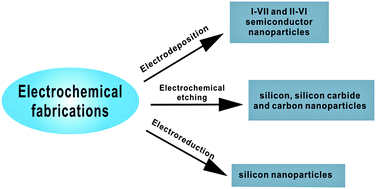
Analyst, 2012,137, 805-815
https://doi.org/10.1039/C2AN15740C
Graphene and graphene -based nanomaterials: the promising materials for bright future of electroanalytical chemistry
This review covers the production, functionalization and application of graphene – the promising material for the bright future of electroanalytical chemistry.
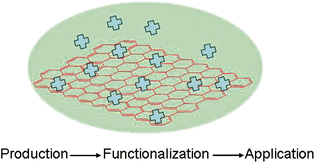
Analyst, 2011,136, 4631-4640
https://doi.org/10.1039/C1AN15661F
Motion-driven sensing and biosensing using electrochemically propelled nanomotors
Isolation of biomaterials based on receptor-functionalized microengines.

Analyst, 2011,136, 4621-4630
https://doi.org/10.1039/C1AN15599G
Novel nanobiotechnological concepts in electrochemical biosensors for the analysis of toxins
The incorporation of novel nanobiotechnological concepts such as aptamers, nanoparticles, nanotubes and magnetic beads, in sensing and transducing strategies is providing with high-performance electrochemical biosensors for toxin detection.
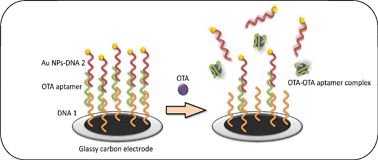
Analyst, 2012,137, 1055-1067
https://doi.org/10.1039/C2AN15736E
Capacitively coupled contactless conductivity detection on microfluidic systems—ten years of development
This review covers the main features related to the instrumental setup of capacitively coupled contactless conductivity detection for analytical and bioanalytical assays on microfluidic chips.
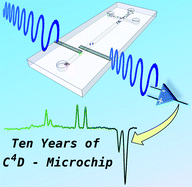
Anal. Methods, 2012,4, 25-33
https://doi.org/10.1039/C1AY05364G
Recent advances in electrochemical sensing for hydrogen peroxide : a review
Due to the significance of hydrogen peroxide in biological systems and practical applications, the development of efficient electrochemical H2O2 sensors holds a special attraction for researchers. The aim of this review is to summarize the recent advances since 2000 and gain an insight into the materials used in the electrocatalytic sensing of H2O2.
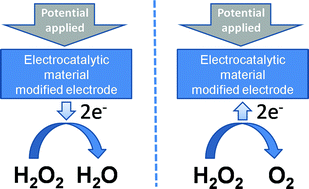
Analyst, 2012,137, 49-58
https://doi.org/10.1039/C1AN15738H
On the stability of the silver/silver sulfate reference electrode
The preparation and application of a simple silver/silver sulfate reference electrode for aqueous solution, which can be used as an alternative in chloride-free systems, is presented.
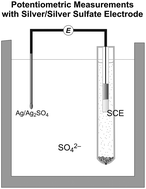
Anal. Methods, 2012,4, 1207-1211
https://doi.org/10.1039/C2AY00011C
Anatase TiO2 nanoparticle–graphene nanocomposites: One-step preparation and their enhanced direct electrochemistry of hemoglobin
Anatase TiO2 nanoparticle–graphene nanocomposites with enhanced direct electrochemistry of hemoglobin and biosensing for H2O2 were synthesized via a facile, one-step approach in aqueous solution at room temperature.
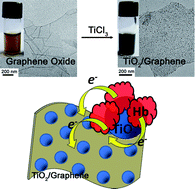
Anal. Methods, 2012,4, 619-622
https://doi.org/10.1039/C2AY05781F
A label-free cytosensor for the enhanced electrochemical detection of cancer cells using polydopamine-coated carbon nanotubes
An electrochemical, label-free method was developed to detect folate receptor positive tumor cells with polydopamine-coated carbon nanotubes–folate nanoprobes.

Analyst, 2012,137, 1316-1318
https://doi.org/10.1039/C2AN16023D
Sensitive and selective voltammetric measurement of Hg2+ by rational covalent functionalization of graphene oxide with cysteamine
A voltammetric method for sensitive and selective Hg2+ determination is demonstrated by rational functionalization of graphene oxide with cysteamine.
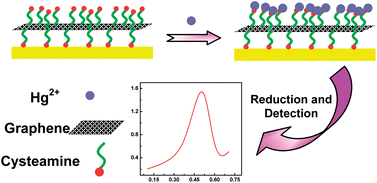
Analyst, 2012,137, 305-308
https://doi.org/10.1039/C1AN15793K
Alkaline phosphatase enzymatic signal amplification for fast, sensitive impedimetric DNA detection
This work presents a method for and a model which explains enhanced DNA detection using an alkaline phosphatase amplification reaction and electrochemical impedance spectroscopy.
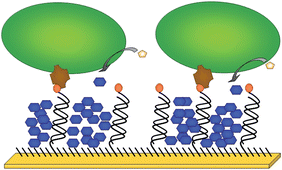
Analyst, 2012,137, 59-63
https://doi.org/10.1039/C1AN15767A
Electrochemical behavior and analytical detection of insulin on pretreated nanocarbon black electrode surface
Pretreated AB/CPE exhibits high accumulation efficiency owing to the presence of nanocarbon particles and anodic pretreatment and the detection limit of insulin was found to be 5.0 × 10−9 M by statistical calculation.
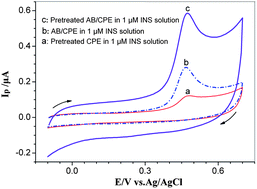
Anal. Methods, 2012,4, 1377-1382
https://doi.org/10.1039/C2AY05828F
The ohmic resistance effect for characterisation of carbon nanotube paste electrodes (CNTPEs)
In this study, carbon nanotube paste electrodes (CNTPEs) have been characterised using their ohmic resistance, RCNTPE, when examining a set of six different electrodes prepared from three types of CNTs and two altered pasting liquids (binders); the latter represented by traditional mineral or silicone oils.
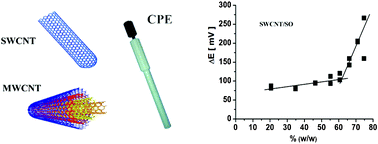
RSC Adv., 2012,2, 3684-3690
https://doi.org/10.1039/C2RA20202F
Monitoring passive transport of redox mediators across a confluent cell monolayer with single-cell resolution by means of scanning electrochemical microscopy
Scanning electrochemical microscopy was used for time-resolved studies of passive transport of substances across cell monolayers. Different transport mechanisms could be distinguished using hydrophilic and lipophilic redox mediators and switching the probe potential.
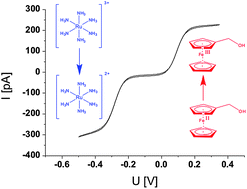
Anal. Methods, 2012,4, 623-629
https://doi.org/10.1039/C1AY05468F
A novel electrochemical sensor based on boronic acid -functionalized multi-walled carbon nanotubes for astragaloside IV determination using ARS as the current indicator
A novel electrochemical sensor based on boronic acid functionalized multi-walled carbon nanotubes was successfully employed to detect astragaloside IV using ARS as the current indicator.
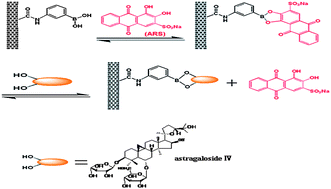
Anal. Methods, 2012,4, 492-495
https://doi.org/10.1039/C1AY05553D
Monitoring of bovine serum albumin using ultrasensitive electrochemiluminescence biosensors based on multilayer CdTe quantum dots modified indium tin oxide electrodes
In a new FI-ECL flow chip, a simple and sensitive sensor reveals good performance for ECL analysis, and opens new avenues for the applications of QDs in ECL biosensors.
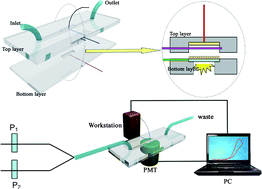
Anal. Methods, 2012,4, 460-466
https://doi.org/10.1039/C1AY05481C
Development of an electrochemical immunosensor for the detection of HbA1c in serum
An electrochemical immuno-biosensor for detecting glycosylated haemoglobin is reported based on glassy carbon electrodes with a mixed layer of an oligo(phenylethynylene) molecular wire and an oligo(ethylene glycol).
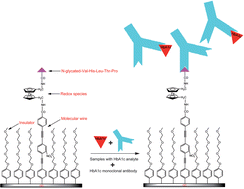
Analyst, 2012,137, 829-832
https://doi.org/10.1039/C2AN16034J
CVD
graphene
vs. highly ordered pyrolytic graphite for use in electroanalytical sensing
The electroanalytical performance of a commercially available CVD grown graphene electrode is explored and contrasted to that of highly ordered pyrolytic graphite electrodes.
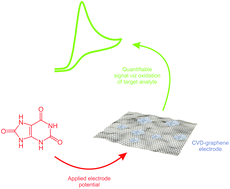
Analyst, 2012,137, 833-839
https://doi.org/10.1039/C2AN16049H
Non-enzymatic electrochemical detection of glycerol on boron-doped diamond electrode
A non-enzymatic direct electrochemical glycerol detection method at a boron-doped diamond electrode in alkaline media is reported.
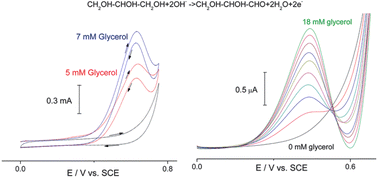
Analyst, 2012,137, 641-647
https://doi.org/10.1039/C2AN15645H
Towards a detailed in situ characterization of non-stationary electrocatalytic systems
A combination of electrogravimetry and electrochemical impedance spectroscopy is introduced as a tool for a detailed characterisation of dynamic electrocatalytic systems.
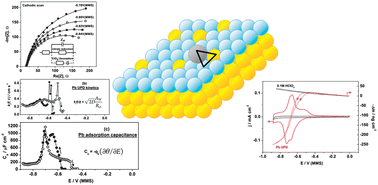
Analyst, 2012,137, 631-640
https://doi.org/10.1039/C1AN15671C
Transition metal ion-substituted polyoxometalates entrapped in polypyrrole as an electrochemical sensor for hydrogen peroxide
Redox behaviour of the Fe3+-substituted Dawson-type polyoxometalate in solution (red curve) and within a polypyrrole film (black curve).
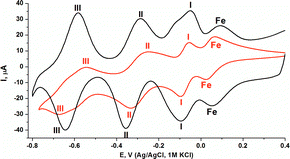
Analyst, 2012,137, 624-630
https://doi.org/10.1039/C1AN15665A
A stannum–bismuth composite film electrode for simultaneous determination of zinc(II) and cadmium(II) using differential pulse anodic stripping voltammetry
The stannum–bismuth composite film electrode revealed good electroanalytical performance for stripping analysis of trace heavy metals.
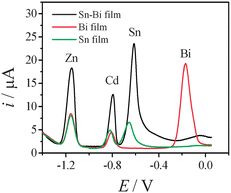
Analyst, 2012,137, 614-617
https://doi.org/10.1039/C1AN15753A
All-solid-state potassium-selective electrode using graphene as the solid contact
Graphene sheets are used for the first time to fabricate a solid-contact ion-selective electrode (SC-ISE) as the intermediate layer.
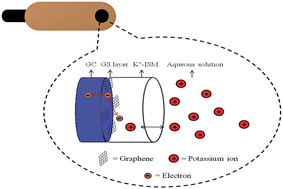
Analyst, 2012,137, 618-623
https://doi.org/10.1039/C1AN15705A
Polyaniline/polyacrylic acid/multi-walled carbon nanotube modified electrodes for sensing ascorbic acid
A multi-walled carbon nanotube composite electrode incorporating polyaniline (PANI) and polyacrylic acid (PAA) is presented. Its electroanalytical performance is explored by diffusing aniline and PAA into Nafion-MWCNTs membranes supported upon a platinum macrodisc electrode.
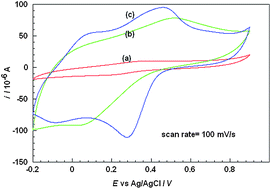
Anal. Methods, 2012,4, 118-124
https://doi.org/10.1039/C1AY05415E
Novel electrode reactions of diazepam , flunitrazepam and lorazepam and their exploitation in a new redox mode LC-DED assay for serum
Previously unreported voltammetric redox behaviour was identified for flunitrazepam, lorazepam and diazepam at a glassy carbon electrode. This was successfully exploited for their determination in serum by high performance liquid chromatography dual electrode detection in the redox mode.
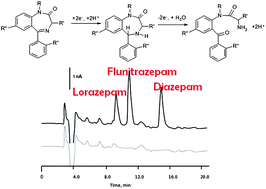
Anal. Methods, 2012,4, 132-140
https://doi.org/10.1039/C1AY05419H
Quantitative characterization of silicon solar cells in the electro-analytical approach: Combined measurements of temperature and voltage dependent electrical parameters
The techniques of impedance spectroscopy and voltammetry have been combined to investigate the effects of temperature and voltage variations on several performance-indicator electrical parameters of a silicon solar cell.
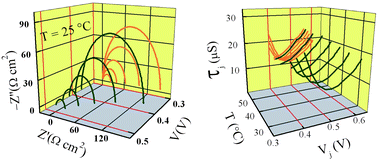
Anal. Methods, 2012,4, 106-117
https://doi.org/10.1039/C1AY05455D
Graphene electroanalysis: Inhibitory effects in the stripping voltammetry of cadmium with surfactant free graphene
Surfactant free graphene is utilised towards the electroanalytical sensing of cadmium where surprisingly we find there to be no advantages of employing graphene in this analytical context.
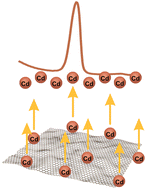
Analyst, 2012,137, 420-423
https://doi.org/10.1039/C1AN15967D
Redox magnetohydrodynamics enhancement of stripping voltammetry of lead(II), cadmium(II) and zinc(II) ions using 1,4-benzoquinone as an alternative pumping species
Redox-magnetohydrodynamics with 1,4-benzoquinone enhances preconcentration in differential pulse anodic stripping analysis of metals, giving improved detection limits, without rinsing.

Analyst, 2012,137, 424-431
https://doi.org/10.1039/C1AN15700K
Electropolymerized network of polyamidoamine dendron-coated gold nanoparticles as novel nanostructured electrode surface for biosensor construction
Novel Au nanoparticles with PAMAM G-4 dendron and aniline moieties were prepared and electropolymerized on a gold electrode surface. This 3D matrix was used to build an enzyme biosensor towards cathecol.

Analyst, 2012,137, 342-348
https://doi.org/10.1039/C1AN15850C
Resolution of phenolic antioxidant mixtures employing a voltammetric bio-electronic tongue
The present work describes the application of a novel bio-electronic tongue using an array of enzyme-modified voltammetric biosensors to the simultaneous determination of phenolic compounds in wine.

Analyst, 2012,137, 349-356
https://doi.org/10.1039/C1AN15456G
Study on electrochemical oxidation behaviors and the diffusion mechanism of hydroquinone at pre-anodized carbon paste electrode by cyclic voltammetry
The consumption of H+ on the cathode provided the driving force for hydroquinone transport towards the anode to be oxidized to quinone.
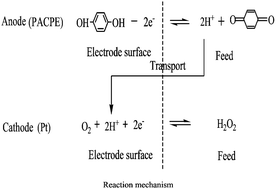
Analyst, 2012,137, 432-436
https://doi.org/10.1039/C1AN15865A
Synthesis of MgFe2O4 nanoparticles and MgFe2O4 nanoparticles /CPE for electrochemical investigation of dopamine
The MgFe2O4 NPs/CPE exhibits good electrocatalytic activity and the detection limit of dopamine was found to be 7.7 × 10−8 M by statistical calculation.
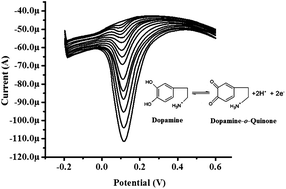
Anal. Methods, 2011,3, 2792-2796
https://doi.org/10.1039/C1AY05483J
Complex electrochemical and impedimetric evaluation of DNA damage by using DNA biosensor based on a carbon screen-printed electrode
Voltammetric responses of DNA bases (G), intercalator (Th), [Fe(CN)6]3−/4− (ΔIrel) and charge transfer resistance (ΔRct,rel) indicate gradual changes such as helix opening, single strand breaks up to leaching of DNA fragments from the electrode.
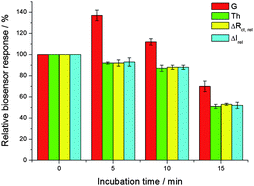
Anal. Methods, 2011,3, 2777-2782
https://doi.org/10.1039/C1AY05403A
Redox switching and oxygen evolution at oxidized metal and metal oxide electrodes : iron in base
Hydrous iron oxyhydroxide films grown by potential cycling are effective electrocatalysts for the energetically demanding anodic oxygen evolution reaction.

Phys. Chem. Chem. Phys., 2011,13, 21530-21551
https://doi.org/10.1039/C1CP22470K
Electrochemical sensor for neurotransmitters at physiological pH using a heterocyclic conducting polymer modified electrode
Simultaneous determination of two neurotransmitters, norepinephrine (NEP) and serotonin (5-HT) was achieved using the electropolymerized film of 3-amino-5-mercapto-1,2,4-triazole.
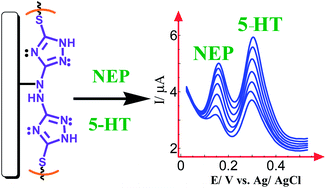
Analyst, 2012,137, 209-215
https://doi.org/10.1039/C1AN15746A
Electrocatalytic reaction of hydrogen peroxide and NADH based on poly(neutral red) and FAD hybrid film
A simple method to immobilize poly(neutral red) (PNR) and flavin adenine dinucleotide (FAD) hybrid film (PNR/FAD) by cyclic voltammetry is proposed.

Analyst, 2012,137, 186-194
https://doi.org/10.1039/C1AN15739F
A glucose /oxygen enzymatic fuel cell based on redox polymer and enzyme immobilisation at highly-ordered macroporous gold electrodes
Co-immobilisation of enzymes and redox hydrogels within highly ordered macroporous gold electrodes provides improved power output from a glucose/oxygen biofuel cell operating under physiological conditions.

Analyst, 2012,137, 113-117
https://doi.org/10.1039/C1AN15537G
A microfluidic device based on a screen-printed carbon electrode with electrodeposited gold nanoparticles for the detection of IgG anti-Trypanosoma cruziantibodies
A microfluidic device coupled to a screen-printed carbon electrode with electrodeposited gold nanoparticles for the alternative serological diagnosis of Chagas disease was developed.
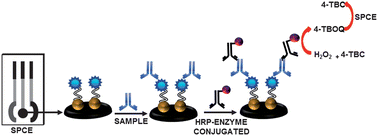
Analyst, 2011,136, 4745-4751
https://doi.org/10.1039/C1AN15569E
Asymmetric logistic peak as a suitable function for the resolution of highly asymmetric voltammograms in non-bilinear systems
A parametric function is proposed for the resolution of non-bilinear voltammetric data including highly asymmetric signals measured by differential pulse and linear sweep voltammetries.
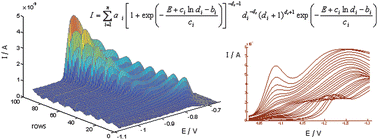
Analyst, 2011,136, 4696-4703
https://doi.org/10.1039/C1AN15396J
Chemically-modified graphenes for oxidation of DNA bases: analytical parameters
Graphite oxide, graphene oxide, electrochemically reduced graphene oxide and thermally reduced graphene oxide show differences in surface functionalities, structure and defect density and these largely influence their electrochemical behaviour in detecting the oxidation of DNA bases.

Analyst, 2011,136, 4738-4744
https://doi.org/10.1039/C1AN15631D
Electrochemical DNA sensor by the assembly of graphene and DNA-conjugated gold nanoparticles with silver enhancement strategy
A novel electrochemical DNA biosensor was developed based on a DNA-assembling graphene platform with gold nanoparticles-catalyzed silver enhancement strategy.
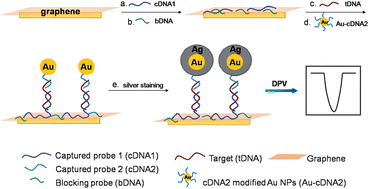
Analyst, 2011,136, 4732-4737
https://doi.org/10.1039/C1AN15610A
A disposable sensor for point of care wound pH monitoring
The development of a disposable pH sensor for the point of care monitoring of wound pH is described.

Analyst, 2011,136, 4692-4695
https://doi.org/10.1039/C1AN15675F
Determination of morphine at gold nanoparticles /Nafion ® carbon paste modified sensor electrode
Nafion enhances the determination of morphine at the gold modified carbon paste electrode.
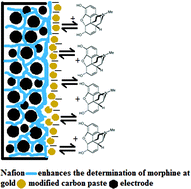
Analyst, 2011,136, 4682-4691
https://doi.org/10.1039/C1AN15423K
Electrochemical behaviour and voltammetric sensitivity at arrays of nanoscale interfaces between immiscible liquids
The electrochemical behaviour of nanointerface arrays between immiscible electrolyte solutions was examined. The sensitivity to tetraethylammonium cation transfer across the water/1,6-dichloroethane interface increased with decreasing nanointerface size.
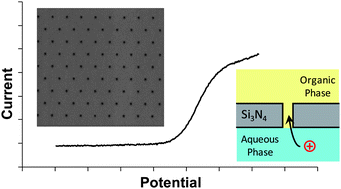
Analyst, 2011,136, 4674-4681
https://doi.org/10.1039/C1AN15509A
Electrochemical identification of artificial oligonucleotides related to bovine species. Potential for identification of species based on mismatches in the mitochondrial cytochrome C1 oxidase gene
Bovine species were discriminated on gold surfaces by placing the mitochondrial DNA using electrochemical impedance spectroscopy and scanning electrochemical microscopy.
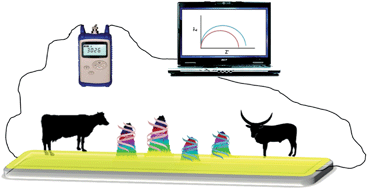
Analyst, 2011,136, 4724-4731
https://doi.org/10.1039/C1AN15414A
About this collection
This web theme across Analyst, Analytical Methods and other RSC journals highlights important developments and novel applications in the exciting area of electroanalytical science.